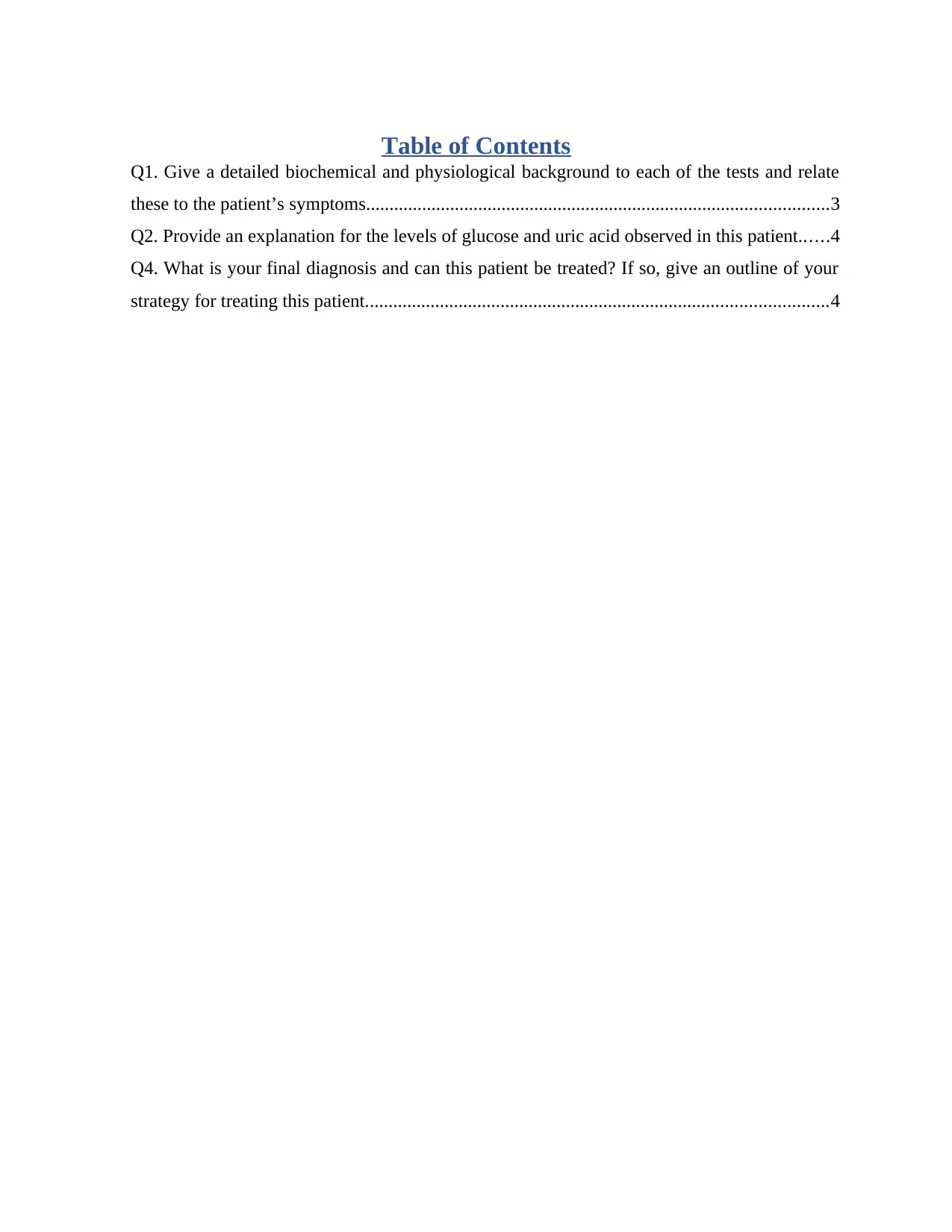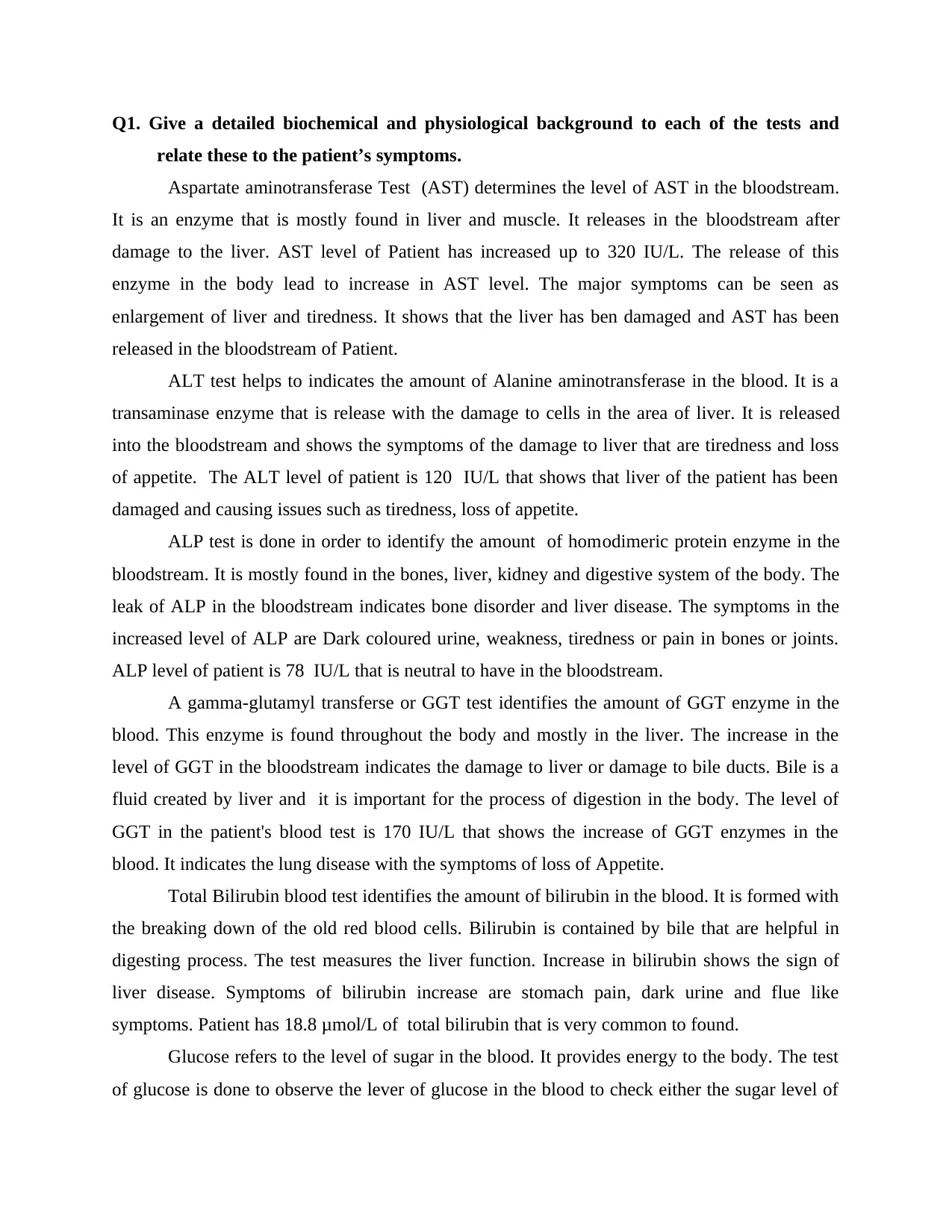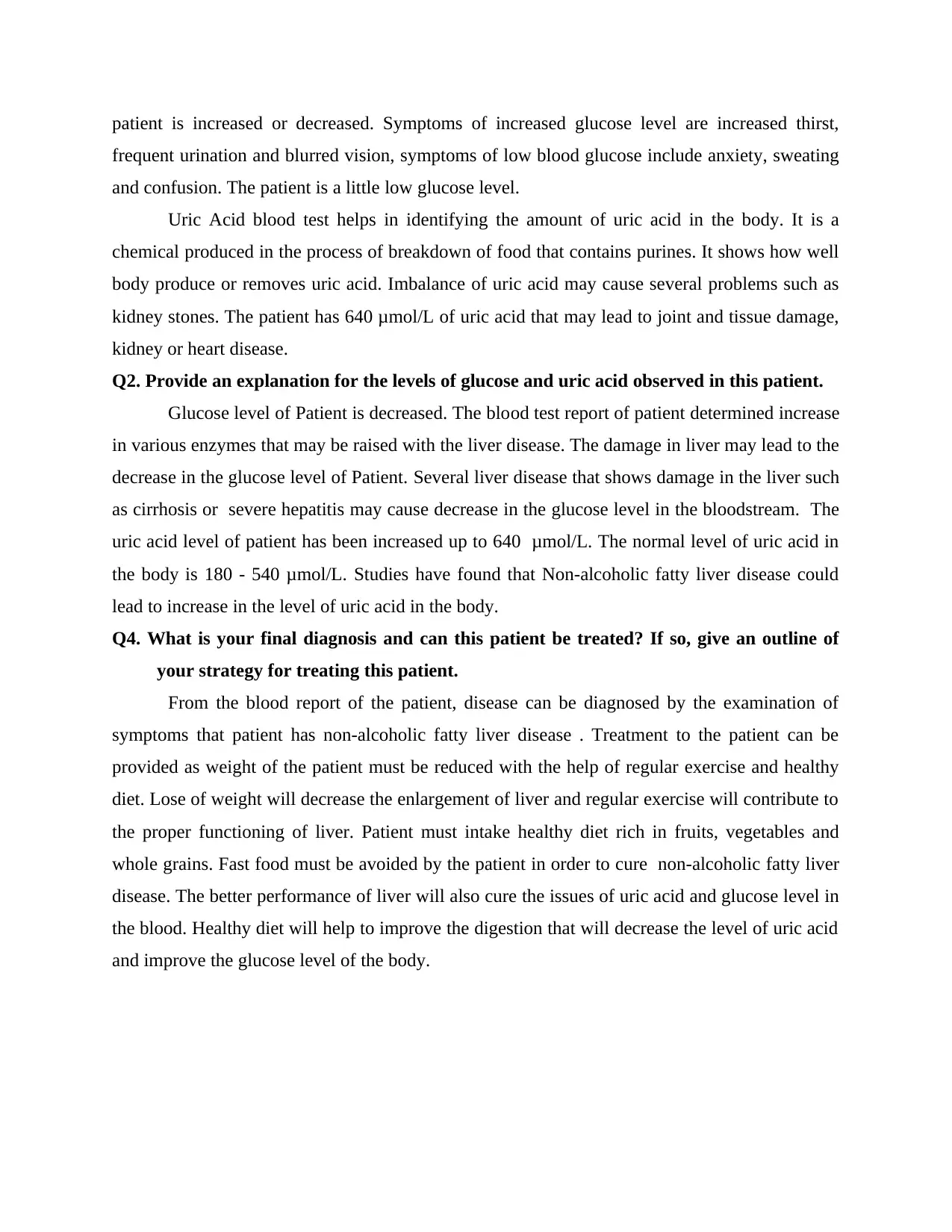Non-Alcoholic Fatty Liver Disease: Diagnosis and Treatment Plan
VerifiedAdded on 2023/06/15
|5
|1037
|170
Case Study
AI Summary
This case study focuses on a 60-year-old male presenting with symptoms of tiredness, lack of energy, and vague abdominal pain, leading to a diagnosis of non-alcoholic fatty liver disease (NAFLD). The analysis includes a detailed biochemical and physiological background of relevant blood tests such as AST, ALT, ALP, GGT, bilirubin, glucose, and uric acid, relating these to the patient's symptoms. Elevated levels of AST, ALT, and GGT, along with abnormal glucose and uric acid levels, are explained in the context of liver dysfunction and NAFLD. The final diagnosis of NAFLD is made based on the patient's symptoms and blood test results, and a treatment strategy involving weight loss through regular exercise and a healthy diet rich in fruits, vegetables, and whole grains is recommended to improve liver function and address the associated metabolic imbalances.

Project
Paraphrase This Document
Need a fresh take? Get an instant paraphrase of this document with our AI Paraphraser

Table of Contents
Q1. Give a detailed biochemical and physiological background to each of the tests and relate
these to the patient’s symptoms...................................................................................................3
Q2. Provide an explanation for the levels of glucose and uric acid observed in this patient......4
Q4. What is your final diagnosis and can this patient be treated? If so, give an outline of your
strategy for treating this patient...................................................................................................4
Q1. Give a detailed biochemical and physiological background to each of the tests and relate
these to the patient’s symptoms...................................................................................................3
Q2. Provide an explanation for the levels of glucose and uric acid observed in this patient......4
Q4. What is your final diagnosis and can this patient be treated? If so, give an outline of your
strategy for treating this patient...................................................................................................4

Q1. Give a detailed biochemical and physiological background to each of the tests and
relate these to the patient’s symptoms.
Aspartate aminotransferase Test (AST) determines the level of AST in the bloodstream.
It is an enzyme that is mostly found in liver and muscle. It releases in the bloodstream after
damage to the liver. AST level of Patient has increased up to 320 IU/L. The release of this
enzyme in the body lead to increase in AST level. The major symptoms can be seen as
enlargement of liver and tiredness. It shows that the liver has ben damaged and AST has been
released in the bloodstream of Patient.
ALT test helps to indicates the amount of Alanine aminotransferase in the blood. It is a
transaminase enzyme that is release with the damage to cells in the area of liver. It is released
into the bloodstream and shows the symptoms of the damage to liver that are tiredness and loss
of appetite. The ALT level of patient is 120 IU/L that shows that liver of the patient has been
damaged and causing issues such as tiredness, loss of appetite.
ALP test is done in order to identify the amount of homodimeric protein enzyme in the
bloodstream. It is mostly found in the bones, liver, kidney and digestive system of the body. The
leak of ALP in the bloodstream indicates bone disorder and liver disease. The symptoms in the
increased level of ALP are Dark coloured urine, weakness, tiredness or pain in bones or joints.
ALP level of patient is 78 IU/L that is neutral to have in the bloodstream.
A gamma-glutamyl transferse or GGT test identifies the amount of GGT enzyme in the
blood. This enzyme is found throughout the body and mostly in the liver. The increase in the
level of GGT in the bloodstream indicates the damage to liver or damage to bile ducts. Bile is a
fluid created by liver and it is important for the process of digestion in the body. The level of
GGT in the patient's blood test is 170 IU/L that shows the increase of GGT enzymes in the
blood. It indicates the lung disease with the symptoms of loss of Appetite.
Total Bilirubin blood test identifies the amount of bilirubin in the blood. It is formed with
the breaking down of the old red blood cells. Bilirubin is contained by bile that are helpful in
digesting process. The test measures the liver function. Increase in bilirubin shows the sign of
liver disease. Symptoms of bilirubin increase are stomach pain, dark urine and flue like
symptoms. Patient has 18.8 μmol/L of total bilirubin that is very common to found.
Glucose refers to the level of sugar in the blood. It provides energy to the body. The test
of glucose is done to observe the lever of glucose in the blood to check either the sugar level of
relate these to the patient’s symptoms.
Aspartate aminotransferase Test (AST) determines the level of AST in the bloodstream.
It is an enzyme that is mostly found in liver and muscle. It releases in the bloodstream after
damage to the liver. AST level of Patient has increased up to 320 IU/L. The release of this
enzyme in the body lead to increase in AST level. The major symptoms can be seen as
enlargement of liver and tiredness. It shows that the liver has ben damaged and AST has been
released in the bloodstream of Patient.
ALT test helps to indicates the amount of Alanine aminotransferase in the blood. It is a
transaminase enzyme that is release with the damage to cells in the area of liver. It is released
into the bloodstream and shows the symptoms of the damage to liver that are tiredness and loss
of appetite. The ALT level of patient is 120 IU/L that shows that liver of the patient has been
damaged and causing issues such as tiredness, loss of appetite.
ALP test is done in order to identify the amount of homodimeric protein enzyme in the
bloodstream. It is mostly found in the bones, liver, kidney and digestive system of the body. The
leak of ALP in the bloodstream indicates bone disorder and liver disease. The symptoms in the
increased level of ALP are Dark coloured urine, weakness, tiredness or pain in bones or joints.
ALP level of patient is 78 IU/L that is neutral to have in the bloodstream.
A gamma-glutamyl transferse or GGT test identifies the amount of GGT enzyme in the
blood. This enzyme is found throughout the body and mostly in the liver. The increase in the
level of GGT in the bloodstream indicates the damage to liver or damage to bile ducts. Bile is a
fluid created by liver and it is important for the process of digestion in the body. The level of
GGT in the patient's blood test is 170 IU/L that shows the increase of GGT enzymes in the
blood. It indicates the lung disease with the symptoms of loss of Appetite.
Total Bilirubin blood test identifies the amount of bilirubin in the blood. It is formed with
the breaking down of the old red blood cells. Bilirubin is contained by bile that are helpful in
digesting process. The test measures the liver function. Increase in bilirubin shows the sign of
liver disease. Symptoms of bilirubin increase are stomach pain, dark urine and flue like
symptoms. Patient has 18.8 μmol/L of total bilirubin that is very common to found.
Glucose refers to the level of sugar in the blood. It provides energy to the body. The test
of glucose is done to observe the lever of glucose in the blood to check either the sugar level of
⊘ This is a preview!⊘
Do you want full access?
Subscribe today to unlock all pages.

Trusted by 1+ million students worldwide

patient is increased or decreased. Symptoms of increased glucose level are increased thirst,
frequent urination and blurred vision, symptoms of low blood glucose include anxiety, sweating
and confusion. The patient is a little low glucose level.
Uric Acid blood test helps in identifying the amount of uric acid in the body. It is a
chemical produced in the process of breakdown of food that contains purines. It shows how well
body produce or removes uric acid. Imbalance of uric acid may cause several problems such as
kidney stones. The patient has 640 μmol/L of uric acid that may lead to joint and tissue damage,
kidney or heart disease.
Q2. Provide an explanation for the levels of glucose and uric acid observed in this patient.
Glucose level of Patient is decreased. The blood test report of patient determined increase
in various enzymes that may be raised with the liver disease. The damage in liver may lead to the
decrease in the glucose level of Patient. Several liver disease that shows damage in the liver such
as cirrhosis or severe hepatitis may cause decrease in the glucose level in the bloodstream. The
uric acid level of patient has been increased up to 640 μmol/L. The normal level of uric acid in
the body is 180 - 540 μmol/L. Studies have found that Non-alcoholic fatty liver disease could
lead to increase in the level of uric acid in the body.
Q4. What is your final diagnosis and can this patient be treated? If so, give an outline of
your strategy for treating this patient.
From the blood report of the patient, disease can be diagnosed by the examination of
symptoms that patient has non-alcoholic fatty liver disease . Treatment to the patient can be
provided as weight of the patient must be reduced with the help of regular exercise and healthy
diet. Lose of weight will decrease the enlargement of liver and regular exercise will contribute to
the proper functioning of liver. Patient must intake healthy diet rich in fruits, vegetables and
whole grains. Fast food must be avoided by the patient in order to cure non-alcoholic fatty liver
disease. The better performance of liver will also cure the issues of uric acid and glucose level in
the blood. Healthy diet will help to improve the digestion that will decrease the level of uric acid
and improve the glucose level of the body.
frequent urination and blurred vision, symptoms of low blood glucose include anxiety, sweating
and confusion. The patient is a little low glucose level.
Uric Acid blood test helps in identifying the amount of uric acid in the body. It is a
chemical produced in the process of breakdown of food that contains purines. It shows how well
body produce or removes uric acid. Imbalance of uric acid may cause several problems such as
kidney stones. The patient has 640 μmol/L of uric acid that may lead to joint and tissue damage,
kidney or heart disease.
Q2. Provide an explanation for the levels of glucose and uric acid observed in this patient.
Glucose level of Patient is decreased. The blood test report of patient determined increase
in various enzymes that may be raised with the liver disease. The damage in liver may lead to the
decrease in the glucose level of Patient. Several liver disease that shows damage in the liver such
as cirrhosis or severe hepatitis may cause decrease in the glucose level in the bloodstream. The
uric acid level of patient has been increased up to 640 μmol/L. The normal level of uric acid in
the body is 180 - 540 μmol/L. Studies have found that Non-alcoholic fatty liver disease could
lead to increase in the level of uric acid in the body.
Q4. What is your final diagnosis and can this patient be treated? If so, give an outline of
your strategy for treating this patient.
From the blood report of the patient, disease can be diagnosed by the examination of
symptoms that patient has non-alcoholic fatty liver disease . Treatment to the patient can be
provided as weight of the patient must be reduced with the help of regular exercise and healthy
diet. Lose of weight will decrease the enlargement of liver and regular exercise will contribute to
the proper functioning of liver. Patient must intake healthy diet rich in fruits, vegetables and
whole grains. Fast food must be avoided by the patient in order to cure non-alcoholic fatty liver
disease. The better performance of liver will also cure the issues of uric acid and glucose level in
the blood. Healthy diet will help to improve the digestion that will decrease the level of uric acid
and improve the glucose level of the body.
Paraphrase This Document
Need a fresh take? Get an instant paraphrase of this document with our AI Paraphraser

1 out of 5
Your All-in-One AI-Powered Toolkit for Academic Success.
+13062052269
info@desklib.com
Available 24*7 on WhatsApp / Email
![[object Object]](/_next/static/media/star-bottom.7253800d.svg)
Unlock your academic potential
Copyright © 2020–2025 A2Z Services. All Rights Reserved. Developed and managed by ZUCOL.


